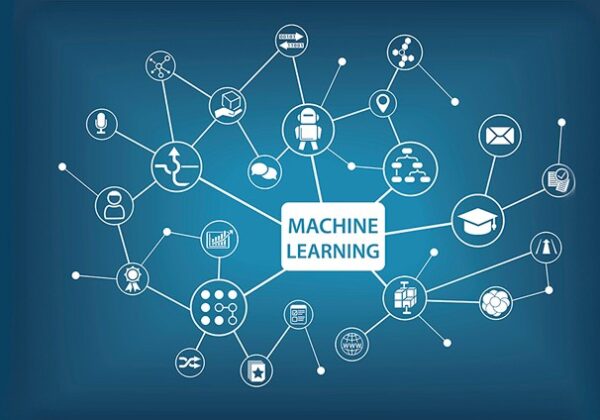One of the most intriguing technologies of our time, machine learning (ML) is incredibly versatile and potent. It’s utilized by a number of companies, including Netflix, Facebook, Amazon, and many more.
Artificial intelligence (AI) and machine learning are no longer the stuff of science fiction; instead, they’re a $1.41 billion industry that’s already revolutionizing the way we perceive and use enormous databases for a variety of uses. Machine learning and artificial intelligence (AI) have the potential to disrupt and improve our current processes in almost every area of society, from helping to support cutting-edge cancer research to assisting businesses in tracking their inventory.
Related Reading: History Of Machine Learning
Table of Contents
The Market For Machine Learning Is Prepared Well
According to research done by Helomics, the market for AI worldwide is predicted to reach $20 billion by 2025. Additionally, machine learning, which has the potential to disrupt entrenched industries, offers growth opportunities in addition to AI. AI is one of humanity’s best future allies because it enables business leaders to make more informed decisions, researchers to approach problems in novel ways, and it provides insights around-the-clock that no human could possibly contextualize alone.
It also brings with it a huge market opportunity and the chance to ride the next major disruption to success. In fact, according to 86% of survey participants from 2021 PWC, AI technology is now widely used in their organizations. As a result of the COVID-19 pandemic and its effects on businesses and workplaces around the world, more than 52% also reported accelerating adoption plans for machine learning and AI technology.
Benefits Of Machine Learning And AI
It is obvious why you might want to have an AI on your side given these capabilities. The increased sophistication of the technology, its greater accessibility, and the advantages it provides are driving its adoption. The following are some of the advantages that are most frequently mentioned by various kinds of organizations:
- Customer satisfaction has increased: The PWC survey found that 86% of businesses claimed AI had improved their customer experiences. As a result, brand loyalty and customer satisfaction both increased.
- Making wise decisions AI aided decision-making and strategy for 75% of business leaders at the top of the organization. Better results and competitive advantages follow from that.
- Increased innovation: 75% of organizations who’ve fully implemented an AI solution claimed they improved their offerings to better meet the needs of their target customers by innovating on already-existing goods and services.
- Cost savings: AI is particularly good at streamlining procedures and identifying waste that can be eliminated. 70% of organizations said they were able to reduce costs and save some important capital thanks to AI solutions.
- Boosted productivity: Following the adoption of AI solutions, almost two-thirds of businesses reported increased productivity. AI acts as a support system for personnel, simplifying tasks and enabling workers to accomplish more than ever. It may even boost employee morale and retention if you have the appropriate tools for your team.
Defining The Future Of Machine Learning
Quantum algorithms have the potential to revolutionize and innovate the field of machine learning. Faster data processing is made possible by quantum computing, which enables the execution of concurrent multi-state operations.
With Quantum, machine learning can enhance data analysis and produce deeper insights. Enterprises and businesses may be able to achieve better results with this improved performance compared to more conventional machine learning techniques.
There isn’t a quantum machine learning model that is currently market-ready. The rise of quantum machine learning systems is not that far off, though, as major tech companies are investing in this technology.
End-to-end Model Development Process Facilitated by Automl
The process of using machine learning algorithms to finish tasks in the real world is automated through AutoML, or “Automated Machine Learning.” By streamlining the procedure, AutoML enables businesses to use sophisticated machine learning models and methods without the need for ML specialists.
The wider use of machine learning by AutoML suggests that it has the potential to alter the technological landscape. For instance, to quickly determine which algorithms data scientists can use or whether any algorithms have been missed.
A machine learning model goes through the following stages of development and deployment that can be automated by AutoML:
- Data Preprocessing – With AutoML, data preprocessing enhances data quality, aids in data cleaning by turning unstructured data into structured data, and reduces data, among other things.
- Feature Engineering – the application of AutoML algorithms to help develop more flexible features based on the input data
- Feature Extraction – To create new features that will enhance results and condense data, AutoML uses a variety of datasets.
- Feature Selection – Only useful features or datasets are selected for processing by AutoML in an intelligent manner.
- Hyperparameter Optimisation and Algorithm Selection – The ideal hyperparameters and algorithms are automatically selected by AutoML.
- Model Deployment and Monitoring – The framework is used by AutoML to deploy systems, and dashboards are used to track system performance.
Conclusion
Machine learning algorithms can be used more effectively as new technologies advance. The increased use of machine learning in a variety of industry verticals is clearly predicted by the future of ML. According to Gartner, by 2022, 75% of new end-user solutions utilizing AI and ML will be developed using proprietary platforms as opposed to open-source ones.
Machine learning in the future will present numerous business opportunities. The machine learning revolution and its subsequent future will be with us for a very long time. Check to see if your company is prepared to capitalize on the opportunities ahead.




